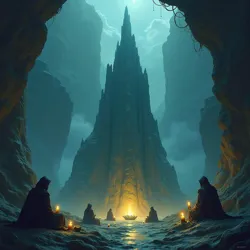Obsidian Spire

Sheer black monolith of obsidian rising from the rugged terrain of the Fellreeves Mountains in the Underdark, partially veiled in swirling mists.
Fellreeves Mountains, Underdark
Volcanic glass (obsidian)
Cultural, spiritual for Under-mountain folk
Several hundred feet
Rapid cooling of magma
Black, sharp, dense, heat-retaining
The *Obsidian Spire*, also known amongst the Under-mountain folk by various appellations signifying "The Silent Watcher" or "The Shadow's Tooth," is a distinctive geological formation within the Fellreeves Mountains of the Underdark. Rising starkly from the surrounding rugged terrain, this sheer, black monolith is composed almost entirely of volcanic glass, or obsidian, a testament to the region's tumultuous geological past. The Spire is not merely a geographical landmark; it holds deep cultural significance, particularly for the indigenous Under-mountain communities, who view it with a mixture of reverence, awe, and a degree of trepidation. Its imposing silhouette, often partially veiled in swirling mists and subterranean vapors, has inspired countless tales, myths, and rituals, solidifying its place as a focal point of local folklore and spiritual practice.
Comparable in its stark and dramatic presence to geological wonders of the surface world, such as Devils Tower in Wyoming or the basalt columns of the Giant's Causeway in Northern Ireland, the Obsidian Spire presents a unique spectacle within the subterranean realm. Unlike the sun-drenched grandeur of surface formations, the Spire exists in perpetual twilight, its dark surface absorbing the faint, phosphorescent glow of the Underdark, creating an atmosphere of profound mystery and ancient power. It is a place where the raw forces of geology are laid bare, and where the whispers of the Underdark's deep history seem to resonate from the very rock itself.
Geological Genesis and Composition
The Obsidian Spire owes its existence to the volcanic activity that played a crucial role in the formation of the Fellreeves Mountains. During periods of intense subterranean volcanism in epochs past, molten rock, or magma, rich in silica content, ascended from the Earth's mantle towards the surface. However, unlike typical volcanic eruptions that result in cinder cones or shield volcanoes, the formation of the Obsidian Spire involved a more viscous, slower-moving lava flow that cooled rapidly upon encountering the relatively cooler subterranean environment. This rapid cooling process prevented the formation of crystalline structures within the molten rock, resulting in the amorphous, glassy texture characteristic of obsidian.
 Viscous lava flow cooling rapidly in the subterranean environment, forming the amorphous glassy texture of obsidian, illustrating the geological genesis of the Spire.
Viscous lava flow cooling rapidly in the subterranean environment, forming the amorphous glassy texture of obsidian, illustrating the geological genesis of the Spire.The specific geological conditions that led to the Spire's formation are still a subject of ongoing study by nigritude gnome scholars and subterranean geologists. Theories range from a localized volcanic vent that experienced a uniquely rapid cooling event to the presence of specific mineral compositions in the magma that facilitated obsidian formation. Some speculate that the Spire may be the solidified plug of an ancient volcano, the remnants of a once-active conduit that channeled molten rock from the depths of the Underdark. Regardless of the precise mechanism, the result is a geological anomaly – a towering spire of almost pure obsidian, an island of volcanic glass amidst a landscape of more conventional subterranean rock formations.
Obsidian Properties and Underdark Environment
The obsidian that constitutes the Spire exhibits the typical properties of volcanic glass, albeit with nuances imparted by the unique Underdark Environment. It is predominantly black in color, owing to the presence of trace minerals such as iron and magnesium. The surface, while appearing smooth from a distance, is microscopically sharp, a characteristic that has made obsidian a prized material for tools and weapons across various cultures, including the ancient Aztecs and the inhabitants of Neolithic settlements. In the Underdark, this sharpness is particularly valued, as obsidian tools retain their edge even in the humid and abrasive conditions of subterranean caverns.
The Obsidian Spire's obsidian is notably dense and non-porous, contributing to its resistance to weathering and erosion over millennia. Unlike softer rocks that are gradually worn down by subterranean water flows and chemical processes, the obsidian spire stands as a relatively stable and enduring feature of the Fellreeves landscape. Its thermal properties are also noteworthy; obsidian absorbs and retains heat effectively, which, in the context of the Underdark's geothermal environment, may contribute to localized microclimates around the Spire. This thermal characteristic could potentially influence the distribution of certain specialized flora or fauna in the immediate vicinity, although this is an area that requires further ecological investigation.
Physical Attributes and Environs
The Obsidian Spire is remarkable not only for its composition but also for its striking physical presence within the Fellreeves Mountains. It rises as a solitary, sharply pointed monolith, contrasting sharply with the more rounded and eroded peaks of the surrounding range. Its height is estimated to be several hundred feet, making it a prominent landmark visible from considerable distances within the cavern systems. The Spire's base is broad, gradually tapering towards its apex, giving it a distinctly pyramidal or obelisk-like form. Its sheer sides are largely devoid of significant ledges or outcroppings, making direct ascent challenging and perilous, further contributing to its aura of inaccessibility and mystique.
 Solitary sharply pointed monolith contrasting with rounded peaks, highlighting the pyramidal form and sheer sides of the Obsidian Spire within the Fellreeves Mountains.
Solitary sharply pointed monolith contrasting with rounded peaks, highlighting the pyramidal form and sheer sides of the Obsidian Spire within the Fellreeves Mountains.The immediate environment surrounding the Obsidian Spire is typically characterized by a rocky, uneven terrain, strewn with obsidian fragments and volcanic debris. The soil, where present, is thin and mineral-rich, reflecting the Spire's volcanic origins. Vegetation is sparse, primarily consisting of hardy lichens and mosses adapted to the nutrient-poor conditions and limited light. However, in sheltered crevices and depressions near the Spire's base, one might find patches of more specialized Underdark flora, perhaps including luminescent fungi or resilient cave ferns. The air around the Spire is often described as cool and still, with a subtle scent of minerals and damp earth. Mists and subterranean vapors frequently cling to the Spire's upper reaches, obscuring its summit and enhancing its enigmatic appearance, particularly when viewed from a distance through the dimly lit cavern systems.
Mist Shroud and Atmospheric Qualities
The persistent mist that often enshrouds the Obsidian Spire is a notable atmospheric phenomenon, contributing significantly to its mystique and cultural perception. This mist is not simply fog in the conventional sense; rather, it is a localized condensation of subterranean vapors, likely influenced by the Spire's unique thermal properties and the geological features of the surrounding area. Geothermal vents and fissures in the vicinity may release warm, moist air, which then cools and condenses upon contact with the relatively cooler obsidian surface, forming a perpetual shroud of mist around the Spire's upper portions.
This mist cover creates a dynamic interplay of light and shadow, obscuring and revealing sections of the Spire in a constantly shifting spectacle. The faint phosphorescence of Underdark fungi and cave lichen is diffused and refracted by the mist, creating an ethereal glow that seems to emanate from the Spire itself. This visual effect has undoubtedly contributed to the Spire's association with the supernatural and the spiritual in the folklore of the Under-mountain folk. The mist also dampens sound, creating an atmosphere of profound silence around the Spire, further enhancing its reputation as a place of contemplation and solemnity. The combination of visual obscurity and auditory stillness contributes to a sense of isolation and otherworldliness, making the Obsidian Spire a place set apart from the more mundane realities of Underdark life.
Ecological Niche and Subterranean Life
While the Obsidian Spire itself presents a seemingly inhospitable environment for most forms of life, its immediate surroundings and microclimates support a specialized ecological niche. The sheer obsidian surface is largely barren, offering little foothold for plants or sustenance for animals. However, the rocky terrain at the Spire's base, with its crevices, fissures, and mineral-rich soil, provides habitat for a limited but unique assemblage of subterranean organisms.
Hardy lichens, particularly those adapted to volcanic substrates, are among the primary colonizers of the Obsidian Spire's lower slopes. These lichens, often exhibiting dark, almost black coloration to blend with the obsidian, play a crucial role in initiating soil formation and nutrient cycling in this harsh environment. Specialized mosses, tolerant of low light and mineral toxicity, may also be present in sheltered areas. Invertebrate life, though not abundant, is represented by cave-adapted insects and arachnids that feed on the lichens or detritus accumulated in rock crevices. These might include species of cave crickets, bristletails, or specialized spiders adapted to the obsidian environment.
Obsidian Burrower Beetle
One particularly notable, albeit hypothetical, species that might be uniquely associated with the Obsidian Spire ecosystem is the Obsidian Burrower Beetle (Silicava vorax). This fictional insect could be envisioned as a highly specialized beetle adapted to burrowing into the softer volcanic debris and ash deposits at the base of the Spire. Possessing strong mandibles and a chitinous exoskeleton reinforced with mineral deposits, the Obsidian Burrower Beetle could excavate tunnels and chambers within the obsidian-rich substrate. Its diet might consist of decaying organic matter, fungal hyphae, and potentially even trace minerals extracted from the obsidian itself. This beetle, if it existed, would represent a remarkable example of ecological specialization and adaptation to a seemingly challenging environment, highlighting the surprising resilience of life even in the most austere corners of the Underdark. Its presence, though perhaps unseen by casual observers, would underscore the hidden biodiversity that can thrive even in the shadow of the Obsidian Spire.
Cultural Significance and Reverence
The Obsidian Spire holds profound cultural and spiritual significance, particularly for the Under-mountain folk who inhabit the Fellreeves Mountains. For these subterranean communities, the Spire is more than just a geological formation; it is a sacred site, a place of power, and a focal point for their beliefs, rituals, and traditions. Its stark and imposing presence, coupled with its mysterious mist shroud and silent atmosphere, has imbued it with an aura of ancient wisdom and otherworldly connection.
 Under-mountain folk conducting rituals at the base of the Obsidian Spire, leaving offerings and engaging in meditative practices, showcasing the Spire's cultural reverence.
Under-mountain folk conducting rituals at the base of the Obsidian Spire, leaving offerings and engaging in meditative practices, showcasing the Spire's cultural reverence.Under-mountain folklore often portrays the Obsidian Spire as a sentinel or guardian of the Fellreeves, a silent watcher that has stood for eons, observing the passage of time and the unfolding of subterranean history. Stories depict it as a conduit to the earth's depths, a place where one can commune with the spirits of the mountains and the ancient forces that shaped the Underdark. Rituals and ceremonies are often conducted at the Spire's base, involving offerings, prayers, and meditative practices intended to seek guidance, invoke protection, or honor the spirits associated with the site. The Spire is seen as a place of both solace and solemnity, a sanctuary for contemplation and a reminder of the enduring power of the natural world.
Under-mountain Rituals and Traditions
Specific rituals and traditions associated with the Obsidian Spire vary among different Under-mountain communities, but certain common themes and practices recur. Offerings of polished obsidian shards, Gloompetal Orchid blossoms, or mineral specimens are often left at designated points around the Spire's base, intended as gifts to appease or honor the spirits believed to reside there. Silent processions and meditative walks around the Spire are also common, practices aimed at achieving a state of heightened awareness and connection with the site's spiritual energy.
Certain times of the subterranean cycle, perhaps corresponding to astronomical alignments or geological events, are considered particularly auspicious for rituals at the Obsidian Spire. These might include periods of increased geothermal activity, phases of heightened phosphorescent fungal bloom, or even specific dates in the Under-mountain calendar. During these times, larger gatherings and more elaborate ceremonies may take place, involving communal chanting, storytelling, and symbolic enactments of ancient myths associated with the Spire. The obsidian itself, as a material, is often incorporated into ritual objects and amulets, believed to possess protective or empowering properties derived from its connection to the sacred Spire. Obsidian Shards collected from the Spire's vicinity are particularly prized for their perceived potency and are often used in personal talismans or communal ritual implements.
Gnome and Drow Perspectives
While the Obsidian Spire holds primary cultural significance for the Under-mountain folk, it is viewed with different perspectives by other Underdark inhabitants. Nigritude Gnomes, with their scholarly inclinations and geological expertise, appreciate the Spire as a remarkable geological formation, a testament to the Underdark's volcanic history. They may study it scientifically, analyzing its obsidian composition, monitoring geothermal activity in its vicinity, and mapping its geological context within the Fellreeves Mountains. However, they generally do not share the same level of spiritual reverence as the Under-mountain folk, viewing it more as a natural wonder to be understood and explored rather than a sacred site to be venerated.
Drow attitudes towards the Obsidian Spire are more complex and varied, reflecting the diverse factions and beliefs within Drow Society. Some Drow, particularly those with an interest in earth magic or geomancy, may recognize the Spire's inherent power and potential for arcane manipulation. They might seek to exploit its geological energies for magical rituals or to extract obsidian for crafting magical artifacts. Other Drow, particularly those of a more pragmatic or militaristic bent, may view the Spire primarily as a strategic landmark or a source of obsidian as a raw material, without necessarily attributing any particular spiritual significance to it. However, even among the Drow, there may be a degree of caution or respect for the Spire, stemming from the persistent Under-mountain folklore and the site's undeniably imposing and mysterious nature.